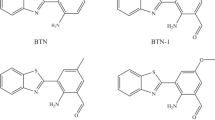Abstract
Spectroscopic and photophysical properties of a Kemp’s tricarboxylic acid derivative having an anthracene chromophore (I) upon recognition of 9-butyladenine (BA) in chloroform were studied in detail. Molecular recognition of BA by Ivia hydrogen-bonding and π—π stacking interactions were sensed successfully on the basis of absorption and fluorescence spectroscopies, by which the binding constant of the I:BA complex was determined to be 240 M−1. The fluorescence quantum yield and lifetime of I in the absence of BA were 0.24 and 5.6 ns, respectively, while those in the presence of an enough amount of BA increased to 0.35 and 13 ns, respectively. These values demonstrated that the nonradiative decay rate constant of I decreased from 13.6 × 107 to 5.0 × 107 s−1 upon binding with BA. Such changes in the photophysical properties of I before and after complexation with BA were discussed in terms of hydrogen-bonding and π—π stacking interactions between I and BA. In particular, intramolecular hydrogen-bonding between the amide and imide groups in I was shown to play important roles in determining the photophysical characteristics of I before complexation, while intermolecular hydrogen-bonding between I and BA governed the excited-state properties of the I:BA complex. The change in the hydrodynamic diameter of I before and after complexation with BA was also discussed on the basis of the results by fluorescence dynamic anisotropy measurements.
Similar content being viewed by others
References
J.-M. Lehn, Supramolecular Chemistry, Concepts and Perspective, VCH, Weinheim, 1995.
D. J. Cram and J. M. Cram, Container Molecules and Their Guests, Monographs in Supramolecular Chemistry, The Royal Society of Chemistry, Cambridge, 1997.
Supramolecular Chemistry of Anions, ed. A. Bianchi, K. Bowman-James and E. Garcia-Espana, Wiley-VCH, New York, 1997.
For biological aspects, see a review article as an example: H. Gohlke and G. Klebe, Approaches to the description and prediction of the binding affinity of small-molecule ligands to macromolecular receptors, Angew. Chem., Int. Ed., 2002, 41, 2644–2676.
For artificial systems, see this review article as an example: L. J. Prins, D. N. Reinhoudt and P. Timmerman, Noncovalent synthesis using hydrogen bonding, Angew. Chem., Int. Ed., 2001, 40, 2382–2426.
A. D. Hamilton and D. V. Engen, Induced fit in synthetic receptors: nucleotide base recognition by a “molecular hinge”, J. Am. Chem. Soc., 1987, 109, 5035–5036.
J. Rebek, Jr, L. Marshall, R. Wolak, K. Parris, M. Killoran, B. Askew, D. Nemeth and N. Islam, Convergent functional groups: synthetic and structural studies, J. Am. Chem. Soc., 1985, 107, 7476–7481.
J. Rebek, Jr, B. Askew, M. Killoran, D. Nemeth, F.-T. Lin, Convergent functional groups. 3. A molecular cleft recognizes substrates of complementary size, shape, and functionality, J. Am. Chem. Soc., 1987, 109, 2426–2431.
J. Rebek, Jr, B. Askew, D. Nemeth and K. Parris, Convergent functional groups. 4. Recognition and transport of amino acids across a liquid membrane, J. Am. Chem. Soc., 1987, 109, 2432–2434.
J. Rebek, Jr, B. Askew, P. Ballester, C. Buhr, S. Jones, D. Nemeth and K. Williams, Molecular recognition: Hydrogen bonding and stacking interactions stabilize a model for nucleic acid structure, J. Am. Chem. Soc., 1987, 109, 5033–5035.
B. Askew, P. Ballester, C. Buhr, K. S. Jeong, S. Jones, K. Parris, K. Williams, J. Rebek, Jr, Molecular recognition with convergent functional groups. 6. Synthetic and structural studies with a model receptor for nucleic acid components, J. Am. Chem. Soc., 1989, 111, 1082–1090.
K. Williams, B. Askew, P. Ballester, C. Buhr, K. S. Jeong, S. Jones, J. Rebek, Jr, Molecular recognition with convergent functional groups. 7. Energetics of adenine binding with model receptors, J. Am. Chem. Soc., 1989, 111, 1090–1094.
D. S. Kemp and K. S. Petrakis, Synthesis and conformational analysis of cis,cis-1,3,5-trimethylcyclohexane-1,3,5-tricarboxylic acid, J. Org. Chem., 1981, 46, 5140–5143.
N. Kitamura, Y. Suzuki, M. Chiba, N. Sakata, H.-B. Kim, Spectroscopic evidence for cooperative binding of a host in molecular hinge, Chem. Lett., 2001, 720–721.
K. C. Murdock and R. B. Angier, Alternative approaches to 1-substituted thymines, J. Org. Chem., 1962, 27, 3317–3319.
T. D. Browne, J. Eisinger and N. J. Leonard, Synthetic spectroscopic models related to coenzymes and base pairs. II. Evidence for intramolecular base–base interactions in dinucleotide analogs, J. Am. Chem. Soc., 1968, 90, 7302–7323.
S. L. Murov, I. Carmichael and G. L. Hug, Handbook of Photochemistry, Marcel-Dekker, New York, 1993.
H.-B. Kim, S. Habuchi and N. Kitamura, Dynamic fluorescence spectroscopic study on the microstructures in ion-exchange resin particles, Anal. Chem., 1999, 71, 842–848.
S. Ishizaka, K. Nakatani, S. Habuchi and N. Kitamura, Total internal reflection fluorescence dynamic anisotropy of sulforhodamine 101 at a liquid/liquid interface: Rotational reorientation times and interfacial structures, Anal. Chem., 1999, 71, 419–426.
J. B. Birks, Photophysics of Aromatic Molecules, Wiley-Interscience, London, 1970.
Under the conditions, more than 90 mol% of I is bound with BA, as estimated from the binding constant: Ka = 240 M−1.
K. A. Connors, The Measurements of Molecular Complex Stability, John-Wiley & Sons, New York, 1987.
N. Mataga and T. Kubota, Molecular Interactions and Electronic Spectra, Marcel Dekker, New York, 1970.
R. L. Christensen, R. C. Drake and D. Phillips, Time-resolved fluorescence anisotropy of perylene, J. Phys. Chem., 1986, 90, 5960–5967.
R. S. Moog, M. D. Ediger, S. G. Boxer and M. D. Fayer, Viscosity dependence of the rotational reorientation of rhodamine B in mono- and polyalcohols. Picosecond transient grating experiments, J. Phys. Chem., 1982, 86, 4694–4700.
S. Ishizaka, S. Kinoshita, Y. Nishijima and N. Kitamura, Direct observation of molecular recognition mediated by triple hydrogen bonds at a water/oil interface: Time-resolved total internal reflection fluorometry study, Anal. Chem., 2003, 75, 6035–6042.
Organic Solvent, Techniques of Chemistry, ed. J. A. Riddik and W. B. Bunger, Wiley-Interscience, New York, 1970, vol. 2.
Author information
Authors and Affiliations
Corresponding author
Additional information
Dedicated to Professor Hiroshi Masuhara on the occasion of his 60th birthday
Rights and permissions
About this article
Cite this article
Kitamura, N., Suzuki, Y. & Ishizaka, S. A spectroscopic and photophysical study on molecular recognition via hydrogen-bonding and π—π stacking interactions. Photochem Photobiol Sci 4, 135–142 (2005). https://doi.org/10.1039/b409932j
Received:
Accepted:
Published:
Issue Date:
DOI: https://doi.org/10.1039/b409932j




